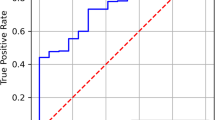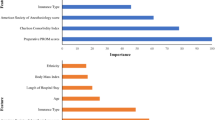Abstract
Purpose
The mechanism by which preoperative expectations may be associated with patient satisfaction and procedural outcomes following hip preservation surgery (HPS) is far from simple or linear. The purpose of this study is to better understand patient expectations regarding HPS and their relationship with patient-reported outcomes (PROs) and satisfaction using machine learning (ML) algorithms.
Methods
Patients scheduled for hip arthroscopy completed the Hip Preservation Surgery Expectations Survey (HPSES) and the pre- and a minimum 2 year postoperative International Hip Outcome Tool (iHOT-33). Patient demographics, including age, gender, occupation, and body mass index (BMI), were also collected. At the latest follow-up, patients were evaluated for subjective satisfaction and postoperative complications. ML algorithms and standard statistics were used.
Results
A total of 69 patients were included in this study (mean age 33.7 ± 13.1 years, 62.3% males). The mean follow-up period was 27 months. The mean HPSES score, patient satisfaction, preoperative, and postoperative iHOT-33 were 83.8 ± 16.5, 75.9 ± 26.9, 31.6 ± 15.8, and 73 ± 25.9, respectively. Fifty-nine patients (86%) reported that they would undergo the surgery again, with no significant difference with regards to expectations. A significant difference was found with regards to expectation violation (p < 0.001). Expectation violation scores were also found to be significantly correlated with satisfaction.
Conclusion
ML algorithms utilized in this study demonstrate that violation of expectations plays an important predictive role in postoperative outcomes and patient satisfaction and is associated with patients’ willingness to undergo surgery again.
Level of evidence
IV.



Similar content being viewed by others
Abbreviations
- HPS:
-
Hip preservation surgery
- PROs:
-
Patient-reported outcomes
- ML:
-
Machine learning
- HPSES:
-
Hip preservation surgery expectations survey
- i-HOT-33:
-
International hip outcome tool
- BMI:
-
Body mass index
- mHHS:
-
Modified harris hip score
- HOS-ADL:
-
Hip outcome score-activities of daily living subscale
- FAIS:
-
Femoral acetabular impingement syndrome
- EXPVIO:
-
Expectations violation
- AGAIN:
-
Patients who reported having the operation again to those regretting the operation
- VS-MPR:
-
Vovk-sellke maximum p-ratio
- MCID:
-
Minimal clinically important difference
References
Alpaydın E (2020) Clustering. Introduction to machine learning, 4th edn. The MIT Press Cambridge, Massachusetts, pp 155–173
Assaf D, Gutman Y, Neuman Y, Segal G, Amit S, Gefen-Halevi S, Shilo N, Epstein A, Mor-Cohen R, Biber A, Rahav G, Levy I, Tirosh A (2020) Utilization of machine-learning models to accurately predict the risk for critical COVID-19. Intern Emerg Med 15(8):1435–1443
Beck EC, Nwachukwu BU, Kunze KN, Chahla J, Nho SJ (2019) How can we define clinically important improvement in pain scores after hip arthroscopy for femoroacetabular impingement syndrome? minimum 2 year follow-up study. Am J Sports Med 47:3133–3140
Chahla J, Beck EC, Nwachukwu BU, Alter T, Harris JD, Nho SJ (2019) Is there an association between preoperative expectations and patient-reported outcome after hip arthroscopy for femoroacetabular impingement syndrome? Arthroscopy 35:3250-3258.e1
Choi ES, Sim JA, Na YG, Seon JK, Shin HD (2021) Machine-learning algorithm that can improve the diagnostic accuracy of septic arthritis of the knee. Knee Surg Sports Traumatol Arthrosc 29:3142–3148
Factor S, Vidra M, Shalom M, Clyman S, Roth Y, Amar E, Rath E (2021) Preoperative expectations do not correlate with postoperative ihot-33 scores and patient satisfaction following hip arthroscopy for the treatment of femoroacetabular impingement syndrome. Arthroscopy 38(6):1869–1875
Hagger MS, Orbell S (2003) A meta-analytic review of the common-sense model of illness representations. Psychol Bull 143(11):1117–1154
Helm JM, Swiergosz AM, Haeberle HS, Karnuta JM, Schaffer JL, Krebs VE, Spitzer AI, Ramkumar PN (2020) Machine learning and artificial intelligence: definitions, applications, and future directions. Curr Rev Musculoskelet Med 13(1):69–76
Jain A, Nandakumar K, Ross A (2005) Score normalization in multimodal biometric systems. Pattern Recogn 38(12):2270–2285
Kunze KN, Krivicich LM, Clapp IM, Bodendorfer BM, Nwachukwu BU, Chahla J, Nho SJ (2021) Machine learning algorithms predict achievement of clinically significant outcomes after orthopaedic surgery: a systematic review. Arthroscopy 8(6):2090–2105
Kunze KN, Polce EM, Clapp I, Nwachukwu BU, Chahla J, Nho SJ (2021) Machine learning algorithms predict functional improvement after hip arthroscopy for femoroacetabular impingement syndrome in athletes. J Bone Joint Surg Am 103(12):1055–1062
Laferton JAC, Oeltjen L, Neubauer K, Ebert DD, Munder T (2022) The effects of patients’ expectations on surgery outcome in total hip and knee arthroplasty: a prognostic factor meta-analysis. Health Psychol Rev 6(1):50–66
Liu Y, Jain A, Eng C, Way DH, Lee K, Bui P, Kanada K, de Oliveira MG, Gallegos J, Gabriele S, Gupta V, Singh N, Natarajan V, Hofmann-Wellenhof R, Corrado GS, Peng LH, Webster DR, Ai D, Huang SJ, Liu Y, Dunn RC, Coz D (2020) A deep learning system for differential diagnosis of skin diseases. Nat Med 26(6):900–908
Lu Y, Forlenza E, Cohn MR, Lavoie-Gagne O, Wilbur RR, Song BM, Krych AJ, Forsythe B (2021) Machine learning can reliably identify patients at risk of overnight hospital admission following anterior cruciate ligament reconstruction. Knee Surg Sports Traumatol Arthrosc 29:2958–2966
Mancuso CA (2022) Editorial commentary: assessing outcomes in terms of fulfillment of patient expectations is complementary to traditional measures including satisfaction. Arthroscopy 38:1876–1878
Mancuso CA, Wentzel CH, Ghomrawi HMK, Kelly BT (2017) Hip preservation surgery expectations survey: a new method to measure patients’ preoperative expectations. Arthroscopy 33(5):959–968
Martin RL, Kivlan BR, Christoforetti JJ, Wolff AB, Nho SJ, Salvo JP, Ellis TJ, Van TG, Matsuda DK, Carreira DS (2019) Minimal clinically important difference and substantial clinical benefit values for the 12-item international hip outcome tool. Arthroscopy 35(2):411–416
McCarthy SC, Lyons AC, Weinman J, Talbot R, Purnell D (2003) Do expectations influence recovery from oral surgery? An illness representation approach. Psychol Heal 18:109–126
Mohtadi NGH, Griffin DR, Pedersen ME, Chan D, Safran MR, Parsons N, Sekiya JK, Kelly BT, Werle JR, Leunig M, McCarthy JC, Martin HD, Byrd JWT, Philippon MJ, Martin RL, Guanche CA, Clohisy JC, Sampson TG, Kocher MS, Larson CM (2012) The development and validation of a self-administered quality-of-life outcome measure for young, active patients with symptomatic hip disease: the International Hip Outcome Tool (iHOT-33). Arthroscopy 28(5):595–605
Naylor CD (2018) On the prospects for a (Deep) learning health care system. JAMA 320(11):1099–1100
Nwachukwu BU, Chang B, Adjei J, Schairer WW, Ranawat AS, Kelly BT, Nawabi DH (2018) Time required to achieve minimal clinically important difference and substantial clinical benefit after arthroscopic treatment of femoroacetabular impingement. Am J Sports Med 46(11):2601–2606
Pinquart M, Rothers A, Gollwitzer M, Khosrowtaj Z, Pietzsch M, Panitz C (2021) Predictors of coping with expectation violation: an integrative review. Rev Gen Psychol 25(3):321–333
Polce EM, Kunze KN, Fu MC, Garrigues GE, Forsythe B, Nicholson GP, Cole BJ, Verma NN (2021) Development of supervised machine learning algorithms for prediction of satisfaction at 2 years following total shoulder arthroplasty. J Shoulder Elbow Surg 30(6):e290–e299
Ramkumar PN, Kunze KN, Haeberle HS, Karnuta JM, Luu BC, Nwachukwu BU, Williams RJ (2021) Clinical and research medical applications of artificial intelligence. Arthroscopy 37(5):1694–1697
Schapire RE. (2003) The Boosting Approach to Machine Learning: An Overview. In: Denison DD, Hansen MH, Holmes CC, Mallick B, Yu B. Nonlinear Estimation and Classification. Lecture Notes in Statistics. Springer, NY. 149–171
Zhang Z (2016) Introduction to machine learning: k-nearest neighbors. Ann Transl Med 4(11):218–225
Funding
No funding was received for this project.
Author information
Authors and Affiliations
Contributions
ER and EA: are equally contributing last authors to this article. All authors that have contributed to this manuscript have agreed on the final revised version of this manuscript. Data are available at reasonable request from the corresponding author.
Corresponding author
Ethics declarations
Conflict of interest
The authors declare no conflicts of interest.
IRB approval
0402–13-TLV.
Additional information
Publisher's Note
Springer Nature remains neutral with regard to jurisdictional claims in published maps and institutional affiliations.
Rights and permissions
Springer Nature or its licensor holds exclusive rights to this article under a publishing agreement with the author(s) or other rightsholder(s); author self-archiving of the accepted manuscript version of this article is solely governed by the terms of such publishing agreement and applicable law.
About this article
Cite this article
Factor, S., Neuman, Y., Vidra, M. et al. Violation of expectations is correlated with satisfaction following hip arthroscopy. Knee Surg Sports Traumatol Arthrosc 31, 2023–2029 (2023). https://doi.org/10.1007/s00167-022-07182-1
Received:
Accepted:
Published:
Issue Date:
DOI: https://doi.org/10.1007/s00167-022-07182-1




